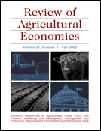Discussant's Response to “Implications from Studies of Foot and Mouth Disease”†
This paper was presented at the session “Analyzing International Public Goods and Trade: Methodological and Policy Implications from Studies of Food and Mouth Disease,” organized at the Allied Social Sciences Association annual meeting in Philadelphia, January 7–9, 2005.
The articles in these sessions are not subject to the journal's standard refereeing process.
The three papers presented in this session on the “Implications from Studies of Foot and Mouth Disease” illustrate the interdependence of economics and livestock-disease control and the importance of good quality, integrated economic and epidemiological information to support decision and policy making.
The paper by Randolph, Morrison, and Poulton extends the traditional evaluation of the benefits and costs of disease-control programs to include poverty-alleviation objectives. A key feature of the analysis is the integration of the economic framework with a stochastic epidemiological model to allow simulating future Foot and Mouth Disease (FMD) outbreaks.
Uncertainty is important in simulating disease outbreaks as the efficacy of control measures and the course of any particular epidemic can vary greatly. Epidemiological analyses frequently incorporate stochastic elements to address these and other uncertainties. Incorporating these disease-related uncertainties into economic analysis is a methodological area deserving of exploration.
The paper by Rich, Winter-Nelson, and Brozović, also illustrates the variance in the efficacy of control measures. The focus in this analysis is on spatial spillovers of FMD virus and the divergent behavior of neighbors in disease control efforts.
This paper employs an application of game theory to model the strategic choices of neighbors involved in disease control and the resulting payoffs. The spatial spillovers of virus among the neighbors affect the payoffs associated with any strategic choice.
The final paper by Jarvis, Bervejillo, and Cancino examines whether beef prices have converged over time among markets where some segmentation may have existed due to the presence or absence of FMD virus. Changes in (1) FMD status, (2) policy related to the FMD-risk associated with importing boneless beef, and (3) commercial trade policies of various countries, are suggested as possible reasons for such convergence.
Jarvis, Bervejillo, and Cancino find evidence in their analysis that beef prices have converged and suggest that the FMD-price differential has narrowed. They discuss the policy changes that may have led to this convergence.
In each of the three studies presented in this session, disease risk is a driving force in decision and policy making. In the study by Randolph, Morrison, and Poulton, information about the risks of FMD outbreaks influences the estimates of the benefits of control strategies. In the study by Rich, Winter-Nelson, and Brozović, information about the risk of virus spillover influences the choice of disease-control strategy. Jarvis et al. report that changes in the understanding about the disease risks of boneless beef imports may have influenced the price differential across markets and generated economic welfare gains.
The need for integration of epidemiological and economic analysis, and incorporating disease risk into economic studies provides rich ground for methodological development. Understanding impacts and interactions among economic systems and ecosystems, such as disease spread among domesticated livestock and wildlife, and related environmental effects, will become increasingly important in the future. The studies presented in this session have added to this body of knowledge.
Acknowledgment
The views and opinions expresses herein are solely those of the author and do not necessarily represent the position of the U.S. Department of Agriculture.




